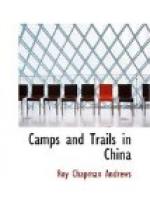We selected positions and the men made a long circuit to drive toward us as Caldwell had directed. After half an hour had passed we heard them yelling as they closed in, but what was our disgust to see them solemnly parading in single file up the bottom of the valley on an open trail and carefully avoiding all thickets where a serow could possibly be. As Harry expressed it, “all the animals had to do was to sit tight and watch the noble procession pass.” The beaters very evidently knew nothing whatever about driving nor were we able to teach them, for they seriously objected to leaving the open trails and going into the bush.
We worked hard for serow but the men were hopeless and it was impossible to “still hunt” the animals at that time of the year. The natives say that in September when the mushrooms are abundant in the lower forests the serow leave the mountain tops and thick cover to feed upon the fungus, and that they may be killed without the aid of beaters, but at any time the hunt would involve a vast amount of labor with only a moderate chance of success. After we had left Fukien, Mr. Caldwell purchased a fine male and female serow for us which are especially interesting as they represent a different subspecies (Capricornis sumatrensis argyrochcaetes) from those we killed in Yuen-nan.
Chi-yuen-kang did yield us results, however, for we discovered a wonderful bat cave less than a mile from our temple. Its entrance was a low round hole half covered with vegetation, and opening into a high circular gallery; from this three long corridors branched off like fingers from the palm of a giant’s hand. The cave was literally alive with bats. There must have been ten thousand and on the first day we killed a hundred, representing seven species and at least four genera. This was especially remarkable as it is unusual to find more than two or three species living together.
The cave was a regular bat apartment house for each corridor was divided by rock partitions into several small rooms in every one of which bats of different species were rearing their families. The young in most instances were only a few days old but were thickly clustered on the walls and ceilings, and each and every one was squeaking at the top of its tiny lungs. The place must have been occupied for scores, if not hundreds, of years for the floor was knee-deep with dung.
When we returned the day after our first visit we found that many of the young bats had been removed by their parents and in some instances entire rooms had been vacated. After the first day the odor of the cave was so nauseating that to enable us to go inside it was necessary to wear gauze pads of iodoform over our noses.
The bats at this place were killed with bamboo switches but later we always used a long gill net which had been especially made in New York. We could hang the net over the entrance to a cave and, when all was ready, send a native into the galleries to stir up the animals. As they flew out they became entangled in the net and could be caught or killed before they were able to get away. It was sometimes possible to catch every specimen in a cavern, and moreover, to secure them in perfect condition without broken skulls or wings.




